Stratification-Induced Porosity Variations in Granular Packings–Part I: From Laboratory Measurement to Numerical Modelling
Abstract
1. Introduction
1.1. Stratification
1.2. Fine Particle Infiltration in Assemblage of Larger Grains
2. Calculation Model
3. Laboratory Experiment
3.1. Methodology
3.1.1. Model Setup and Experiment Procedure
3.1.2. Data Analysis–Determination of the Transition Layer Length, the Minimum and the Average Porosity Within the Transition Layer
3.1.3. Principle of Reliability Assessment of Measurement Results
3.2. Results of Laboratory Research
4. Numerical Simulation
4.1. Methodology
4.1.1. Particula 1.3
4.1.2. Simulation Setup
4.1.3. Data Analysis—An Improved Method for the Identification of the Transition Layer
4.2. Results of Numerical Simulations
4.2.1. Model Calibration and Validation
4.2.2. Comparison of the Two Different Methods for the Transition Layer Identification
4.2.3. Empirical Relationship for LT − R, nm − R and nmin − R
5. Discussion
5.1. Advantages and Limitations of the Calculation Model
5.2. Analysis of Discrepancies Between Experimental Findings and Existing Literature
5.3. Discussion on the Improved Method for the Transition Zone Identification
5.4. Discussion on the Limitations of the Laboratory Experiment Method
5.5. Discussion on the Influence of Water on the Transition Layer Length
5.6. Advantages and Limitations of Numerical Simulations
6. Conclusions and Outlook
Author Contributions
Funding
Institutional Review Board Statement
Informed Consent Statement
Data Availability Statement
Acknowledgments
Conflicts of Interest
Abbreviations
| P | the probability of bridging the pores in the coarse matrix by fine sediment |
| β | trapping coefficient to compute the fraction of fine sediment trapped in the bed |
| f | fine sediment volume fraction for P- and β-model |
| f0 | fine sediment volume fraction at the bed surface P- and β-model. |
| AA and AB | the cross-sectional areas of containers A and B |
| ΔhA and ΔhB | water level change in containers A and B |
| vA and vB | the rates of water level change in containers A and B |
| DTop and DBase | diameter of the top-layer and base-layer spheres |
| DGrain | diameter of spheres in a measurement container |
| DContainer | diameter of the measurement container |
| n | porosity value measured within a container of finite size |
| n0 | porosity value measured in an infinitely large container |
| nm | the average porosity of the transition layer |
| nmin | the minimum porosity within the transition layer |
| ntotal | porosity value in a slice (1 − ρSolid) |
| nstratified | average porosity of a stratified structure |
| nwell-mixed | porosity of a well-mixed sediment sample |
| VSlice | volume of a slice including the volume of top-layer and base-layer particles and the pores. |
| VBase | volume of the base-layer particles in a slice |
| VTop | volume of the top-layer particles in a slice |
| ρBase | density of the base-layer particles in a slice |
| ρTop | density of the top-layer particles in a slice |
| ρsolid | density of all particles in a slice (ρBase + ρTop) |
| ρcut-off | density threshold to identify the lower boundary of the transition layer |
| ρ0 | density of top-layer particles at the base matrix surface |
| ρ1 | density of top-layer particles at the penetration beginning line |
| R | size ratio between the top-layer and base-layer spheres (DBase/DTop) |
| Rc | critical size ratio between the large and small spheres when percolation of small particles is possible |
| R′ | critical value of R corresponding to the onset of unlimited percolation of top-layer particles |
| LTransition_layer | length of the transition layer |
| φ | dimensionless penetration depth |
| φT | dimensionless transition layer length (LTransition layer/DBase) |
| φ*T | dimensionless transition layer length (LTransition layer/max(DBase, DTop)) |
| X | volume fraction of particles with a certain size |
| relative velocity at the contact point for two contacting particles | |
| linear velocity | |
| angular velocity | |
| contact radius vector from the center of mass of a particle to the contact point | |
| normal impulse | |
| contact normal vector, perpendicular to the contact surface at the point of contact | |
| tangential impulse | |
| total impulse | |
| mass of a particle | |
| external forces | |
| external torques | |
| inertia tensor | |
| position quaternion | |
| orientation quaternion |
Appendix A

Appendix B

Appendix C
| Simulation with Glass Beads | |||
|---|---|---|---|
| DBase − DTop (mm) | R | DBase − DTop (mm) | R |
| 10 − 9 | 1.11 | 12 − 3 | 4.00 |
| 10 − 8 | 1.25 | 10 − 2.4 | 4.17 |
| 10 − 7 | 1.43 | 12.5 − 3 | 4.17 |
| 10 − 6 | 1.67 | 12.9 − 3 | 4.30 |
| 10 − 5 | 2.00 | 10 − 2.3 | 4.35 |
| 10 − 4.8 | 2.08 | 13.3 − 3 | 4.43 |
| 10 − 4.6 | 2.17 | 10 − 2.25 | 4.44 |
| 10 − 4.4 | 2.27 | 10 − 2.2 | 4.55 |
| 10 − 4.2 | 2.38 | 10 − 2.15 | 4.65 |
| 10 − 4 | 2.50 | 14 − 3 | 4.67 |
| 10 − 3.8 | 2.63 | 10 − 2.1 | 4.76 |
| 10 − 3.6 | 2.78 | 14.6 − 3 | 4.87 |
| 10 − 3.4 | 2.94 | 11.7 − 2.4 | 4.88 |
| 10 − 3.2 | 3.13 | 10 − 2.05 | 4.88 |
| 10 − 3.1 | 3.23 | 10 − 2.0 | 5.00 |
| 10 − 3 | 3.33 | 15 − 3 | 5.00 |
| 10 − 2.9 | 3.45 | 11.44 − 2.2 | 5.20 |
| 10 − 2.8 | 3.57 | 15.6 − 3 | 5.20 |
| 10 − 2.7 | 3.70 | 16.2 − 3 | 5.40 |
| 10 − 2.6 | 3.85 | 16.8 − 3 | 5.60 |
| 10 − 2.5 | 4.00 | 17.4 − 3 | 5.80 |
Appendix D
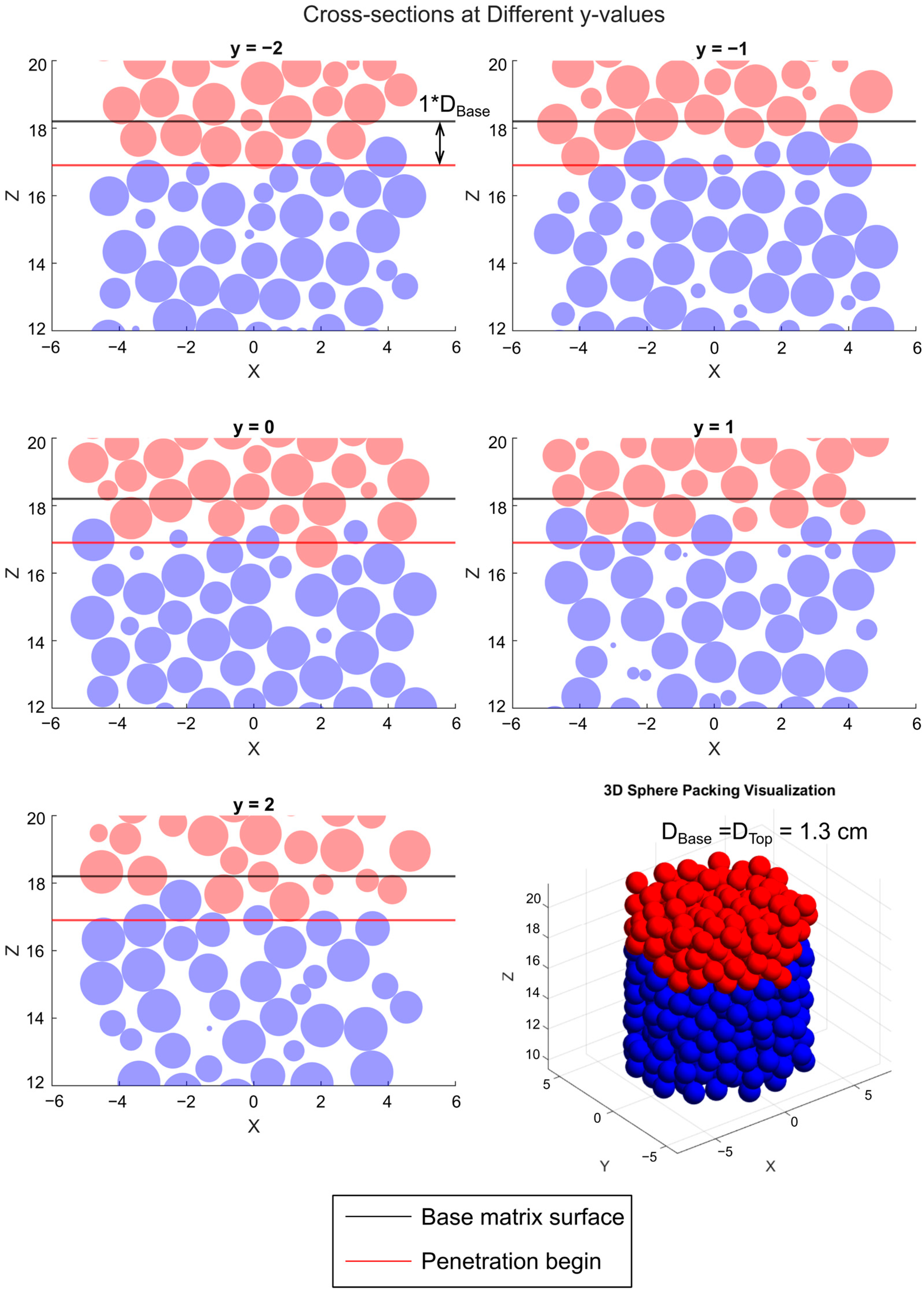
Appendix E
Appendix E.1. Method for Validating the Accuracy of the Calculation Model (3)

Appendix E.2. Results

References
- Pszonka, J.; Schulz, B. SEM Automated Mineralogy applied for the quantification of mineral and textural sorting in submarine sediment gravity flows. Gospod. Surowcami Miner. Miner. Resour. Manag. 2022, 38, 105–131. [Google Scholar] [CrossRef]
- Pszonka, J.; Godlewski, P.; Fheed, A.; Dwornik, M.; Schulz, B.; Wendorff, M. Identification and quantification of intergranular volume using SEM automated mineralogy. Mar. Pet. Geol. 2024, 162, 106708. [Google Scholar] [CrossRef]
- Chwang, A.T.; Chan, A.T. Interaction Between Porous Media and Wave Motion. Annu. Rev. Fluid Mech. 1998, 30, 53–84. [Google Scholar] [CrossRef]
- Ting, C.-L.; Lin, M.-C.; Cheng, C.-Y. Porosity effects on non-breaking surface waves over permeable submerged breakwaters. Coast. Eng. 2004, 50, 213–224. [Google Scholar] [CrossRef]
- Frings, R.M.; Kleinhans, M.G.; Vollmer, S. Discriminating between pore-filling load and bed-structure load: A new porosity-based method, exemplified for the river Rhine. Sedimentology 2008, 55, 1571–1593. [Google Scholar] [CrossRef]
- Frings, R.M. Sedimentary Characteristics of the Gravel-Sand Transition in the River Rhine. J. Sediment. Res. 2011, 81, 52–63. [Google Scholar] [CrossRef]
- Vollmer, S.; Kleinhans, M.G. Predicting incipient motion, including the effect of turbulent pressure fluctuations in the bed. Water Resour. Res. 2007, 43, W05410. [Google Scholar] [CrossRef]
- El Kadi Abderrezzak, K.; Die Moran, A.; Tassi, P.; Ata, R.; Hervouet, J.-M. Modelling river bank erosion using a 2D depth-averaged numerical model of flow and non-cohesive, non-uniform sediment transport. Adv. Water Resour. 2016, 93, 75–88. [Google Scholar] [CrossRef]
- Miwa, H.; Parker, G. Effects of sand content on initial gravel motion in gravel-bed rivers. Earth Surf. Process. Landf. 2017, 42, 1355–1364. [Google Scholar] [CrossRef]
- Mulatu, C.A.; Crosato, A.; Moges, M.M.; Langendoen, E.J.; McClain, M. Morphodynamic Trends of the Ribb River, Ethiopia, Prior to Dam Construction. Geosciences 2018, 8, 255. [Google Scholar] [CrossRef]
- Frings, R.M.; Hillebrand, G.; Gehres, N.; Banhold, K.; Schriever, S.; Hoffmann, T. From source to mouth: Basin-scale morphodynamics of the Rhine River. Earth Sci. Rev. 2019, 196, 102830. [Google Scholar] [CrossRef]
- van Bui, H.; Bui, M.D.; Rutschmann, P. Advanced Numerical Modeling of Sediment Transport in Gravel-Bed Rivers. Water 2019, 11, 550. [Google Scholar] [CrossRef]
- Athy, L.F. Density, Porosity, and Compaction of Sedimentary Rocks. AAPG Bull. 1930, 14, 1–24. [Google Scholar] [CrossRef]
- Hatch, C.E.; Fisher, A.T.; Ruehl, C.R.; Stemler, G. Spatial and temporal variations in streambed hydraulic conductivity quantified with time-series thermal methods. J. Hydrol. 2010, 389, 276–288. [Google Scholar] [CrossRef]
- Aitken, M.J. An Introduction to Optical Dating: The Dating of Quaternary Sediments by The Use of Photon-Stimulated Luminescence; Oxford Science Publications: Oxford, UK; Oxford University Press: New York, NY, USA, 1998. [Google Scholar]
- Goff, J.A.; Kraft, B.J.; Mayer, L.A.; Schock, S.G.; Sommerfield, C.K.; Olson, H.C.; Gulick, S.P.; Nordfjord, S. Seabed characterization on the New Jersey middle and outer shelf: Correlatability and spatial variability of seafloor sediment properties. Mar. Geol. 2004, 209, 147–172. [Google Scholar] [CrossRef]
- Vollmer, S.; de los Santos Ramos, F.; Daebel, H.; Kühn, G. Micro scale exchange processes between surface and subsurface water. J. Hydrol. 2002, 269, 3–10. [Google Scholar] [CrossRef]
- Noack, M.; Ortlepp, J.; Wieprecht, S. An Approach to Simulate Interstitial Habitat Conditions During the Incubation Phase of Gravel-Spawning Fish. River Res. Apps 2017, 33, 192–201. [Google Scholar] [CrossRef]
- Hales, T.C.; McLaughlin, S. A proof of the dodecahedral conjecture. arXiv 1998, arXiv:9811079. [Google Scholar]
- Donev, A.; Cisse, I.; Sachs, D.; Variano, E.A.; Stillinger, F.H.; Connelly, R.; Torquato, S.; Chaikin, P.M. Improving the density of jammed disordered packings using ellipsoids. Science 2004, 303, 990–993. [Google Scholar] [CrossRef] [PubMed]
- Man, W.; Donev, A.; Stillinger, F.H.; Sullivan, M.T.; Russel, W.B.; Heeger, D.; Inati, S.; Torquato, S.; Chaikin, P.M. Experiments on random packings of ellipsoids. Phys. Rev. Lett. 2005, 94, 198001. [Google Scholar] [CrossRef]
- Bernal, J.D.; Finney, J.L. Random close-packed hard-sphere model. II. Geometry of random packing of hard spheres. Discuss. Faraday Soc. 1967, 43, 62–69. [Google Scholar] [CrossRef]
- Haughey, D.P.; Beveridge, G.S.G. Structural properties of packed beds—A review. Can. J. Chem. Eng. 1969, 47, 130–140. [Google Scholar] [CrossRef]
- Carling, P.A.; Reader, N.A. Structure, composition and bulk properties of upland stream gravels. Earth Surf. Process. Landf. 1982, 7, 349–365. [Google Scholar] [CrossRef]
- Wu, W.; Wang, S.S.Y. Formulas for Sediment Porosity and Settling Velocity. J. Hydraul. Eng. 2006, 132, 858–862. [Google Scholar] [CrossRef]
- Wooster, J.K.; Dusterhoff, S.R.; Cui, Y.; Sklar, L.S.; Dietrich, W.E.; Malko, M. Sediment supply and relative size distribution effects on fine sediment infiltration into immobile gravels. Water Resour. Res. 2008, 44, W03424. [Google Scholar] [CrossRef]
- Frings, R.M.; Schüttrumpf, H.; Vollmer, S. Verification of porosity predictors for fluvial sand-gravel deposits. Water Resour. Res. 2011, 47, W07525. [Google Scholar] [CrossRef]
- Stovall, T.; de Larrard, F.; Buil, M. Linear packing density model of grain mixtures. Powder Technol. 1986, 48, 1–12. [Google Scholar] [CrossRef]
- Ouchiyama, N.; Tanaka, T. Porosity estimation for random packings of spherical particles. Ind. Eng. Chem. Fund. 1984, 23, 490–493. [Google Scholar] [CrossRef]
- Yu, A.B.; Standish, N. Estimation of the porosity of particle mixtures by a linear-mixture packing model. Ind. Eng. Chem. Res. 1991, 30, 1372–1385. [Google Scholar] [CrossRef]
- Yu, A.B.; Standish, N. Limitation of proposed mathematical models for the porosity estimation of nonspherical particle mixtures. Ind. Eng. Chem. Res. 1993, 32, 2179–2182. [Google Scholar] [CrossRef]
- Preclik, T.; Rüde, U. Ultrascale simulations of non-smooth granular dynamics. Comp. Part. Mech. 2015, 2, 173–196. [Google Scholar] [CrossRef]
- Schruff, T.; Liang, R.; Rüde, U.; Schüttrumpf, H.; Frings, R.M. Generation of dense granular deposits for porosity analysis: Assessment and application of large-scale non-smooth granular dynamics. Comp. Part. Mech. 2018, 5, 59–70. [Google Scholar] [CrossRef]
- Rettinger, C.; Rüde, U.; Vollmer, S.; Frings, R.M. Effect of sediment form and form distribution on porosity: A simulation study based on the discrete element method. Granul. Matter 2022, 24, 118. [Google Scholar] [CrossRef]
- Boggs, S. Principles of Sedimentology and Stratigraphy, 4th ed.; Pearson Prentice Hall: Upper Saddle River, NJ, USA, 2012. [Google Scholar]
- Mckee, E.D.; Weir, G.W. Terminology for Stratification and Cross-Stratification in Sedimentary Rocks. Geol. Soc. Am. Bull. 1953, 64, 381. [Google Scholar] [CrossRef]
- Miall, A.D. The Geology of Fluvial Deposits: Sedimentary Facies, Basin Analysis, and Petroleum Geology, 4th corrected printing; Springer: Berlin/Heidelberg, Germany, 2006. [Google Scholar]
- Nichols, G. Sedimentology and Stratigraphy, 2nd ed.; Wiley-Blackwell: Chichester, UK; Hoboken, NJ, USA, 2009. [Google Scholar]
- Benito, G.; Sánchez-Moya, Y.; Sopeña, A. Sedimentology of high-stage flood deposits of the Tagus River, Central Spain. Sediment. Geol. 2003, 157, 107–132. [Google Scholar] [CrossRef]
- Guccione, M.J. Grain-Size Distribution of Overbank Sediment and Its Use to Locate Channel Positions. In Alluvial Sedimentation; Marzo, M., Puigdefábregas, C., Eds.; Wiley: Hoboken, NJ, USA, 1993; pp. 185–194. [Google Scholar]
- Burns, C.E.; Mountney, N.P.; Hodgson, D.M.; Colombera, L. Anatomy and dimensions of fluvial crevasse-splay deposits: Examples from the Cretaceous Castlegate Sandstone and Neslen Formation, Utah, USA. Sediment. Geol. 2017, 351, 21–35. [Google Scholar] [CrossRef]
- Chamberlin, E.P.; Hajek, E.A. Fine-sediment Supply Can Control Fluvial Deposit Architecture: An Example From the Blackhawk Formation-Castlegate Sandstone Transition, Upper Cretaceous, Utah, USA. Sediment. Rec. 2022, 20, 1–10. [Google Scholar] [CrossRef]
- Li, P.; Hu, K.; Yu, J. Experimental Investigation on the Permeability and Fine Particle Migration of Debris-Flow Deposits with Discontinuous Gradation: Implications for the Sustainable Development of Debris-Flow Fans in Jiangjia Ravine, China. Sustainability 2024, 16, 10066. [Google Scholar] [CrossRef]
- Church, M.; Jakob, M. What Is a Debris Flood? Water Resour. Res. 2020, 56, e2020WR027144. [Google Scholar] [CrossRef]
- Asbury, H.; Sallenger, J.R. Inverse Grading and Hydraulic Equivalence in Grain-Flow Deposits. J. Sediment. Res. 1979, 49, 553–562. [Google Scholar] [CrossRef]
- Todd, S.P. Stream-driven, high-density gravelly traction carpets: Possible deposits in the Trabeg Conglomerate Formation, SW Ireland and some theoretical considerations of their origin. Sedimentology 1989, 36, 513–530. [Google Scholar] [CrossRef]
- Tucker, M.E. Sedimentary Rocks in the Field, 3rd ed.; John Wiley & Sons: Hoboken, NJ, USA, 2003. [Google Scholar]
- Propster, M.; Szekely, J. The porosity of systems consisting of layers of different particles. Powder Technol. 1977, 17, 123–138. [Google Scholar] [CrossRef]
- Sakthivadivel, R.; Einstein, H.A. Clogging of Porous Column of Spheres by Sediment. J. Hydr. Div. 1970, 96, 461–472. [Google Scholar] [CrossRef]
- Cui, Y.; Wooster, J.K.; Baker, P.F.; Dusterhoff, S.R.; Sklar, L.S.; Dietrich, W.E. Theory of Fine Sediment Infiltration into Immobile Gravel Bed. J. Hydraul. Eng. 2008, 134, 1421–1429. [Google Scholar] [CrossRef]
- Schruff, T. Taking a Closer Look at the Causes and Impacts of Fine Sediment Infiltration into Gravel Beds. Ph.D. Thesis, RWTH Aachen University, Aachen, Germany, 2018. [Google Scholar]
- Huston, D.L.; Fox, J.F. Clogging of Fine Sediment within Gravel Substrates: Dimensional Analysis and Macroanalysis of Experiments in Hydraulic Flumes. J. Hydraul. Eng. 2015, 141, 04015015. [Google Scholar] [CrossRef]
- Dermisis, D.; Papanicolaou, A.N.T. The effects of protruding rock boulders in regulating sediment intrusion within the hyporheic zone of mountain streams. J. Mt. Sci. 2014, 11, 1466–1477. [Google Scholar] [CrossRef]
- Gibson, S.; Heath, R.; Abraham, D.; Schoellhamer, D. Visualization and analysis of temporal trends of sand infiltration into a gravel bed. Water Resour. Res. 2011, 47, W12601. [Google Scholar] [CrossRef]
- Wang, L.; Zhang, Y. Interpreting correlations in stress-dependent permeability, porosity, and compressibility of rocks: A viewpoint from finite strain theory. Numer. Anal. Methods Geomech. 2024, 48, 2000–2019. [Google Scholar] [CrossRef]
- Zhu, X.; Si, G.; Zhang, C.; Moon, J.-S.; Oh, J. Numerical analysis of hydro-mechanical coupling behaviour during shearing of rock fractures based on an improved friction factor model. J. Rock Mech. Geotech. Eng. 2025, 17, 6079–6094. [Google Scholar] [CrossRef]
- Killick, R.; Fearnhead, P.; Eckley, I.A. Optimal Detection of Changepoints with a Linear Computational Cost. J. Am. Stat. Assoc. 2012, 107, 1590–1598. [Google Scholar] [CrossRef]
- Al Ibrahim, M.A.; Kerimov, A.; Mukerji, T.; Mavko, G. Particula: A simulator tool for computational rock physics of granular media. Geophysics 2019, 84, F85–F95. [Google Scholar] [CrossRef]
- Cundall, P.A.; Strack, O.D.L. A discrete numerical model for granular assemblies. Géotechnique 1979, 29, 47–65. [Google Scholar] [CrossRef]
- Pöschel, T.; Schwager, T. Computational Granular Dynamics: Models and Algorithms; Springer: Berlin/Heidelberg, Germany; New York, NY, USA, 2005. [Google Scholar]
- Terdiman, P. Memory-Optimized Bounding-Volume Hierarchies. 2001. Available online: https://www.codercorner.com/Opcode.pdf (accessed on 23 April 2025).
- Hahn, J.K. Realistic animation of rigid bodies. Comput. Graph. 1988, 22, 299–308. [Google Scholar] [CrossRef]
- Mirtich, B.V. Impulsebased Dynamic Simulation of Rigid Body Systems. Ph.D. Thesis, University of California at Berkeley, Berkeley, CA, USA, 1996. [Google Scholar]
- Anitescu, M.; Potra, F.A. Formulating Dynamic Multi-Rigid-Body Contact Problems with Friction as Solvable Linear Complementarity Problems. Nonlinear Dyn. 1997, 14, 231–247. [Google Scholar] [CrossRef]
- Tonge, R.; Benevolenski, F.; Voroshilov, A. Mass splitting for jitter-free parallel rigid body simulation. ACM Trans. Graph. 2012, 31, 105. [Google Scholar] [CrossRef]
- Gavrea, B.I.; Anitescu, M.; Potra, F.A. Convergence of a Class of Semi-Implicit Time-Stepping Schemes for Nonsmooth Rigid Multibody Dynamics. SIAM J. Optim. 2008, 19, 969–1001. [Google Scholar] [CrossRef]
- Tang, H.; Song, R.; Dong, Y.; Song, X. Measurement of Restitution and Friction Coefficients for Granular Particles and Discrete Element Simulation for the Tests of Glass Beads. Materials 2019, 12, 3170. [Google Scholar] [CrossRef] [PubMed]
- Ishibashi, I.; Perry, C.; Agarwal, T.K. Experimental Determinations of Contact Friction for Spherical Glass Particles. Soils Found. 1994, 34, 79–84. [Google Scholar] [CrossRef]
- Peng, L.; Hsia, F.-C.; Woutersen, S.; Bonn, M.; Weber, B.; Bonn, D. Nonmonotonic Friction due to Water Capillary Adhesion and Hydrogen Bonding at Multiasperity Interfaces. Phys. Rev. Lett. 2022, 129, 256101. [Google Scholar] [CrossRef]
- Shen, X.; Lin, M.; Pan, F.; Maa, J.P.-Y.; Ha, H.K.; Bi, Q.; Shao, Y.; Zhang, J.; Wu, Z. Viscosity of Cohesive Sediment-Laden Flows: Experimental and Empirical Methods. JGR Oceans 2024, 129, e2023JC020043. [Google Scholar] [CrossRef]
- van Elderen, P.; Erkens, G.; Zwanenburg, C.; Middelkoop, H.; Stouthamer, E. Viscous compression of clay and peat. Earth-Sci. Rev. 2025, 260, 104993. [Google Scholar] [CrossRef]

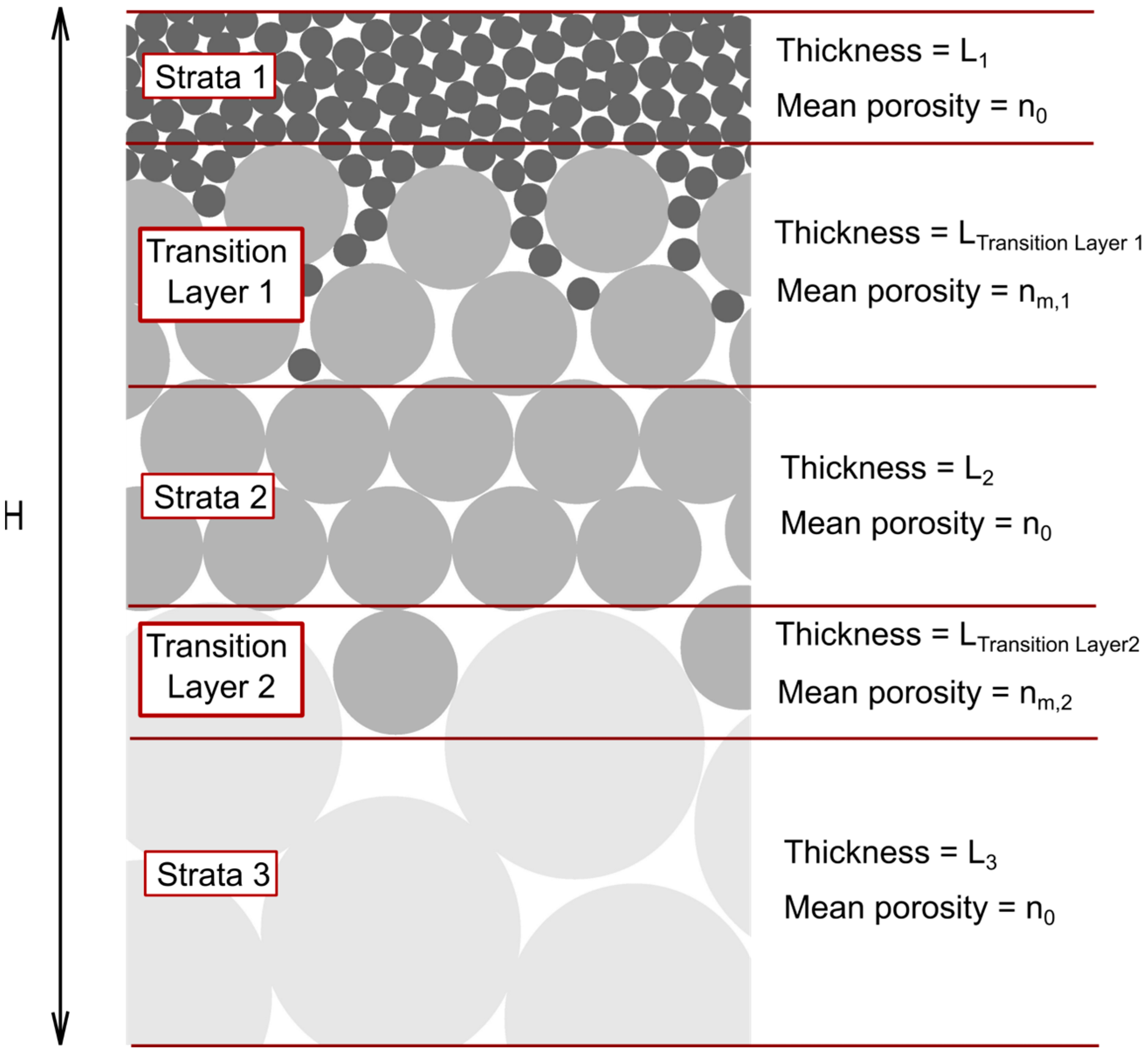
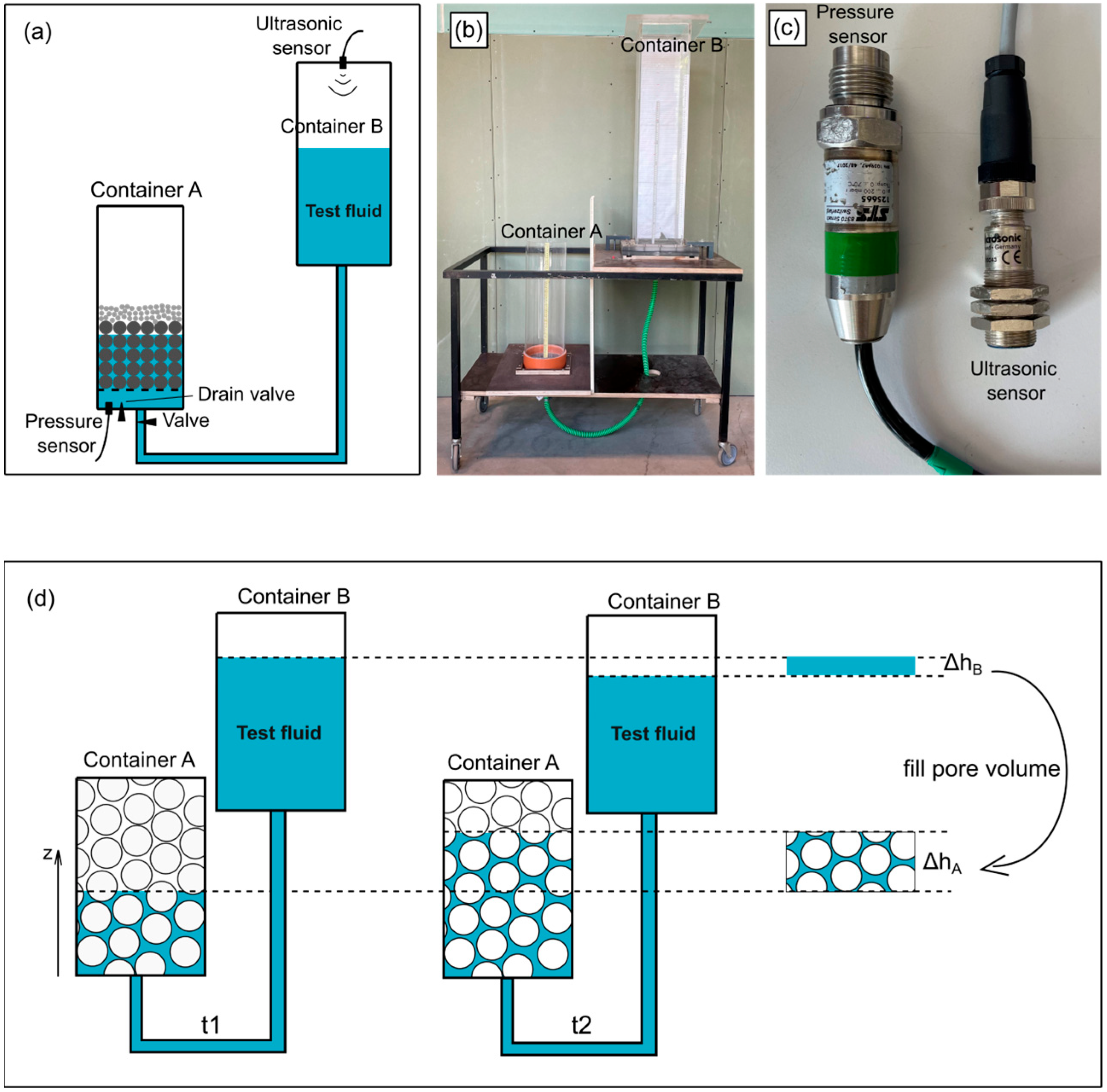
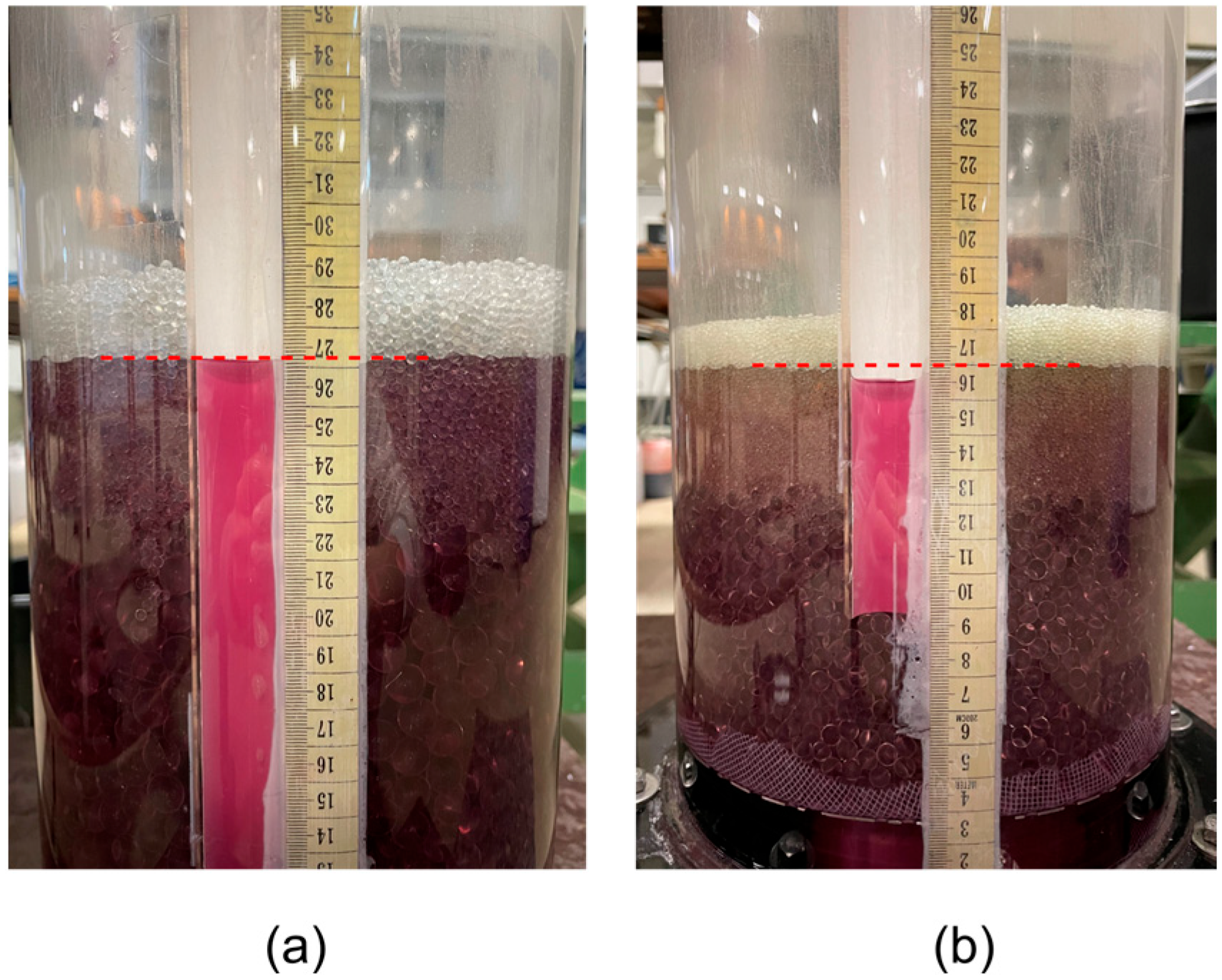

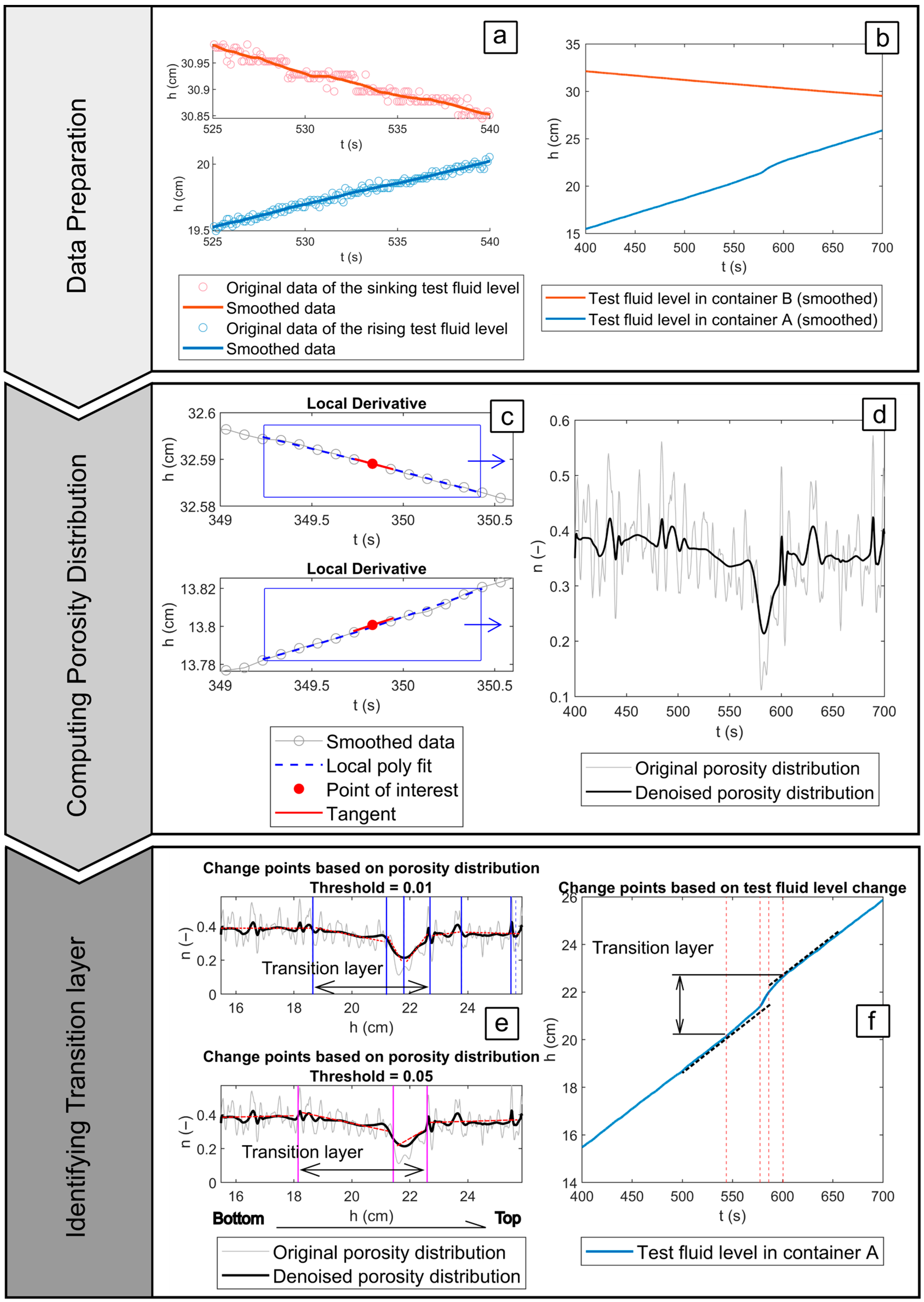
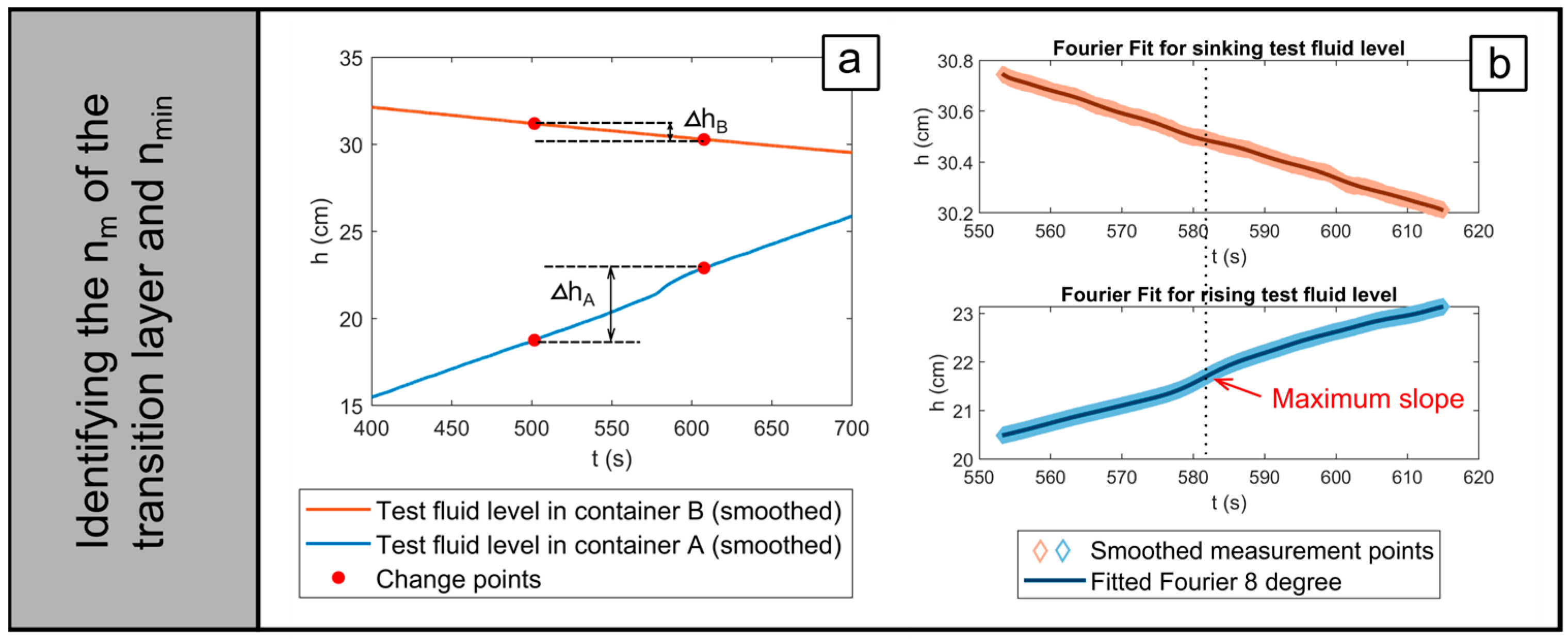
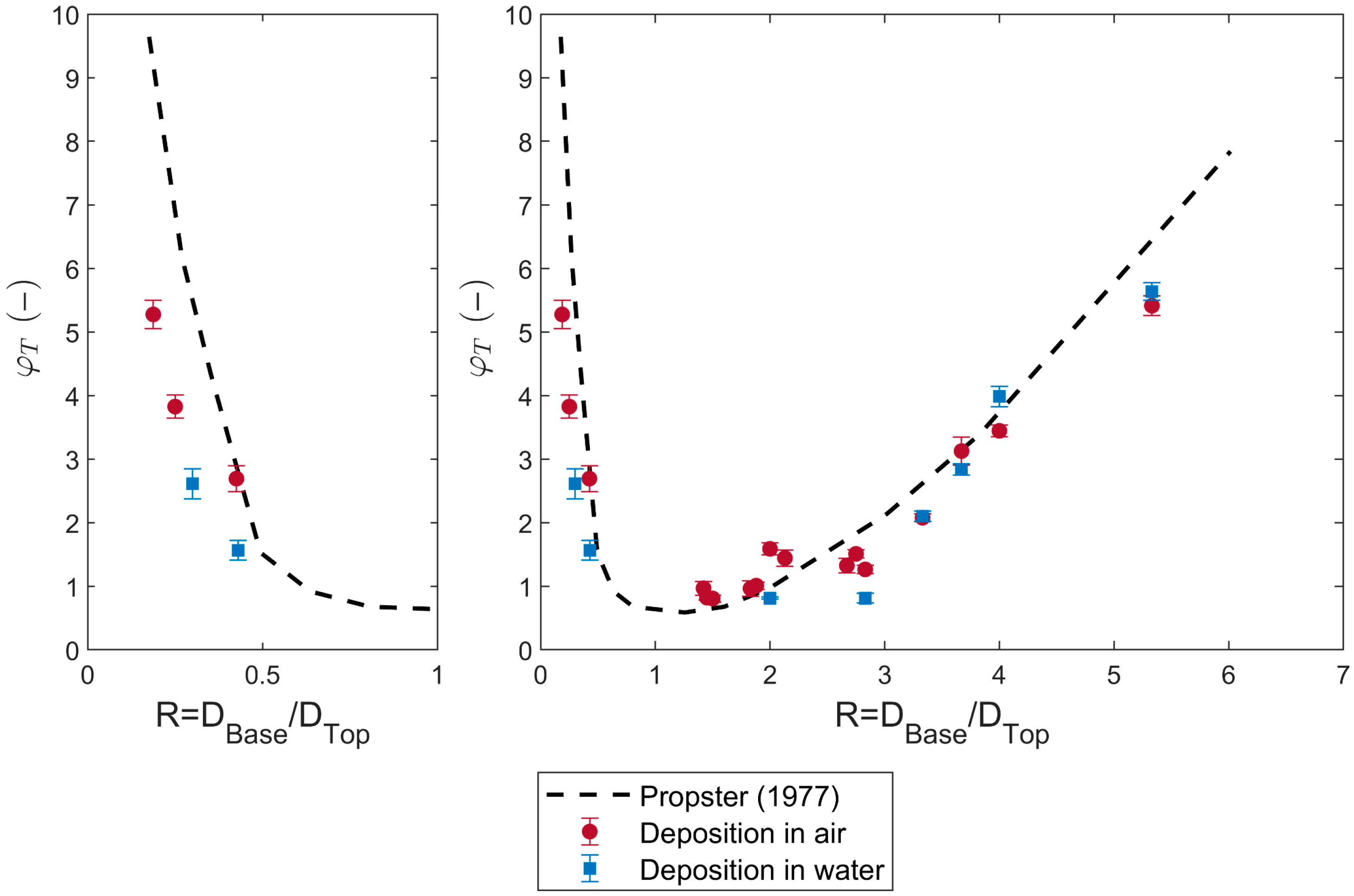



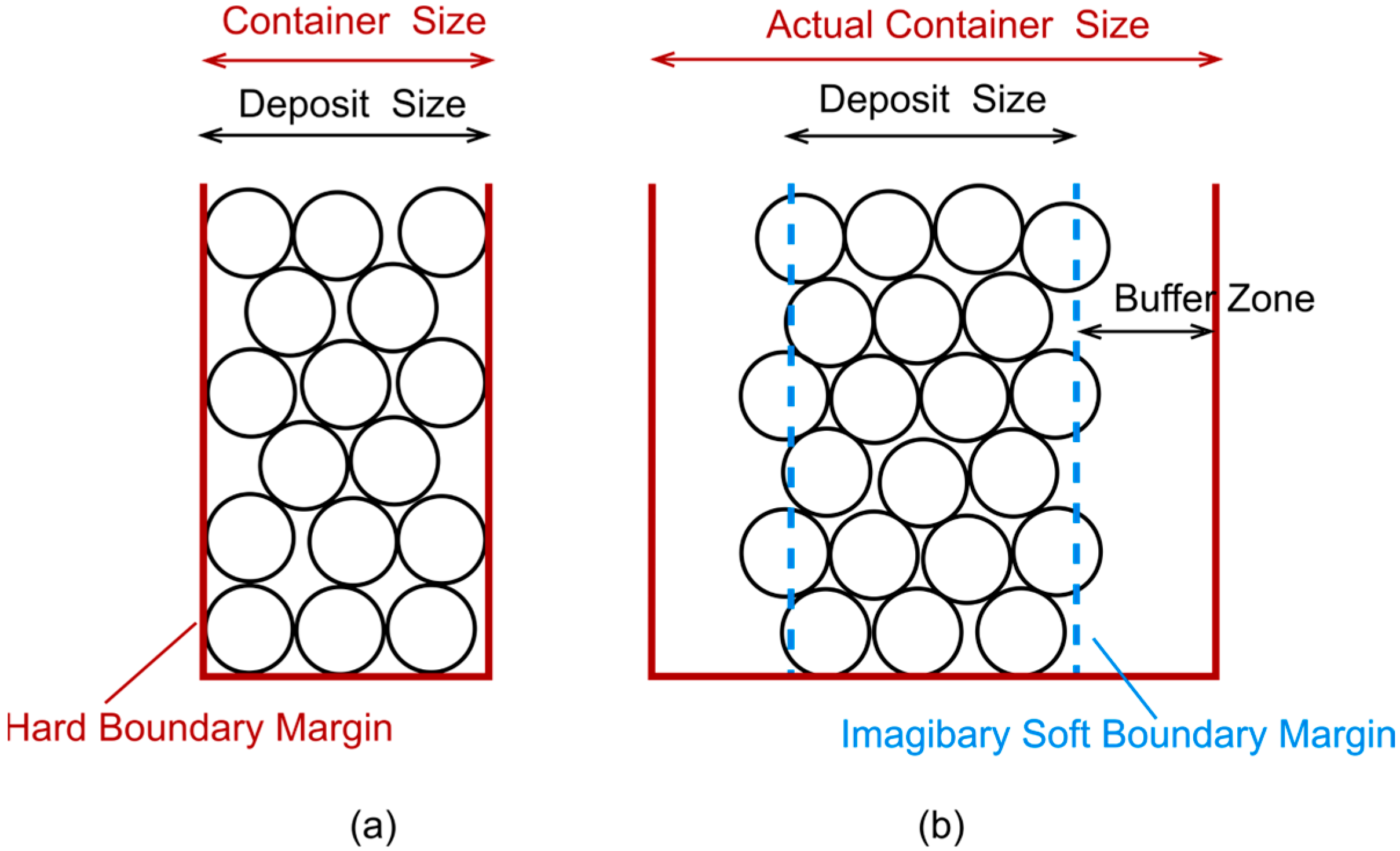
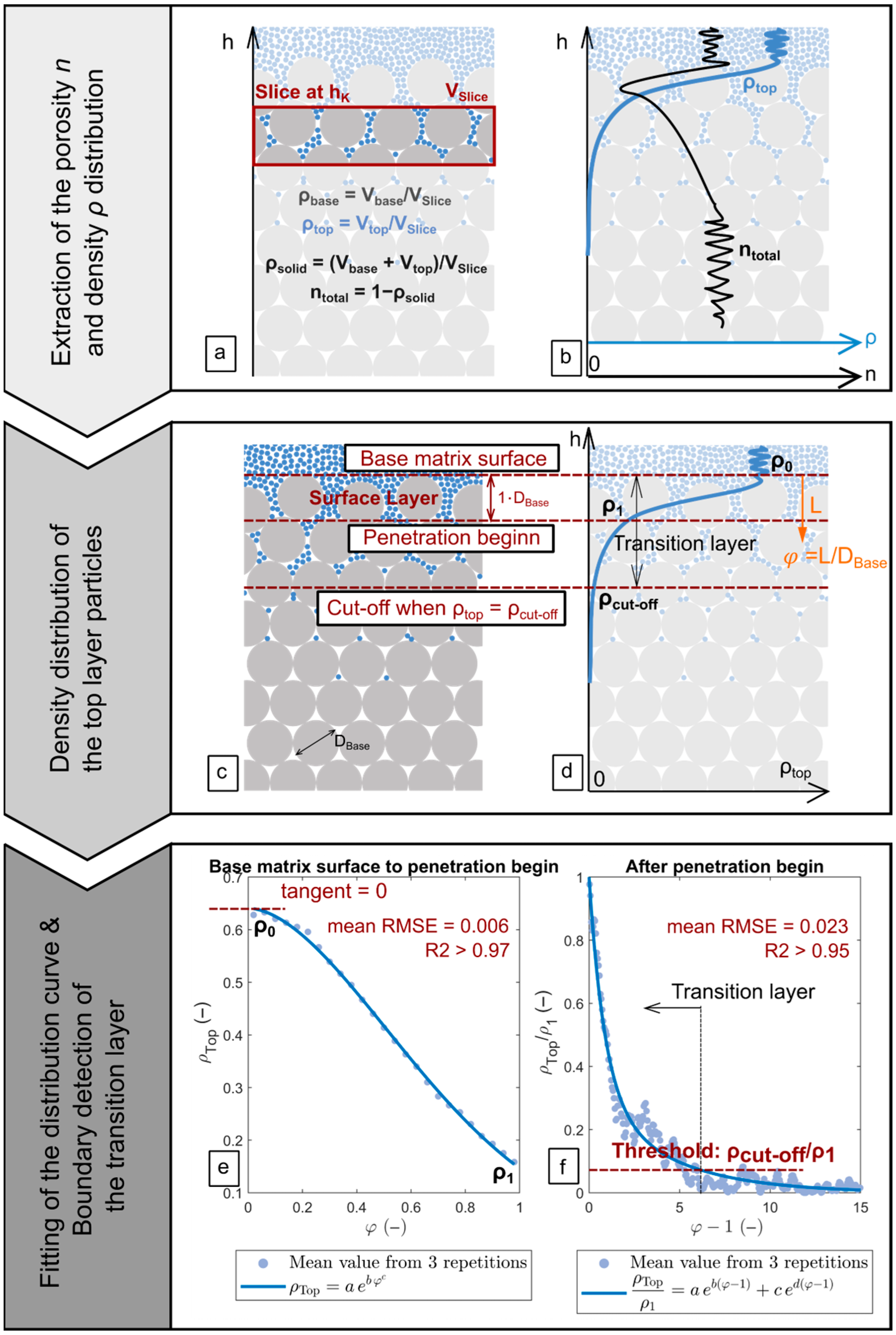

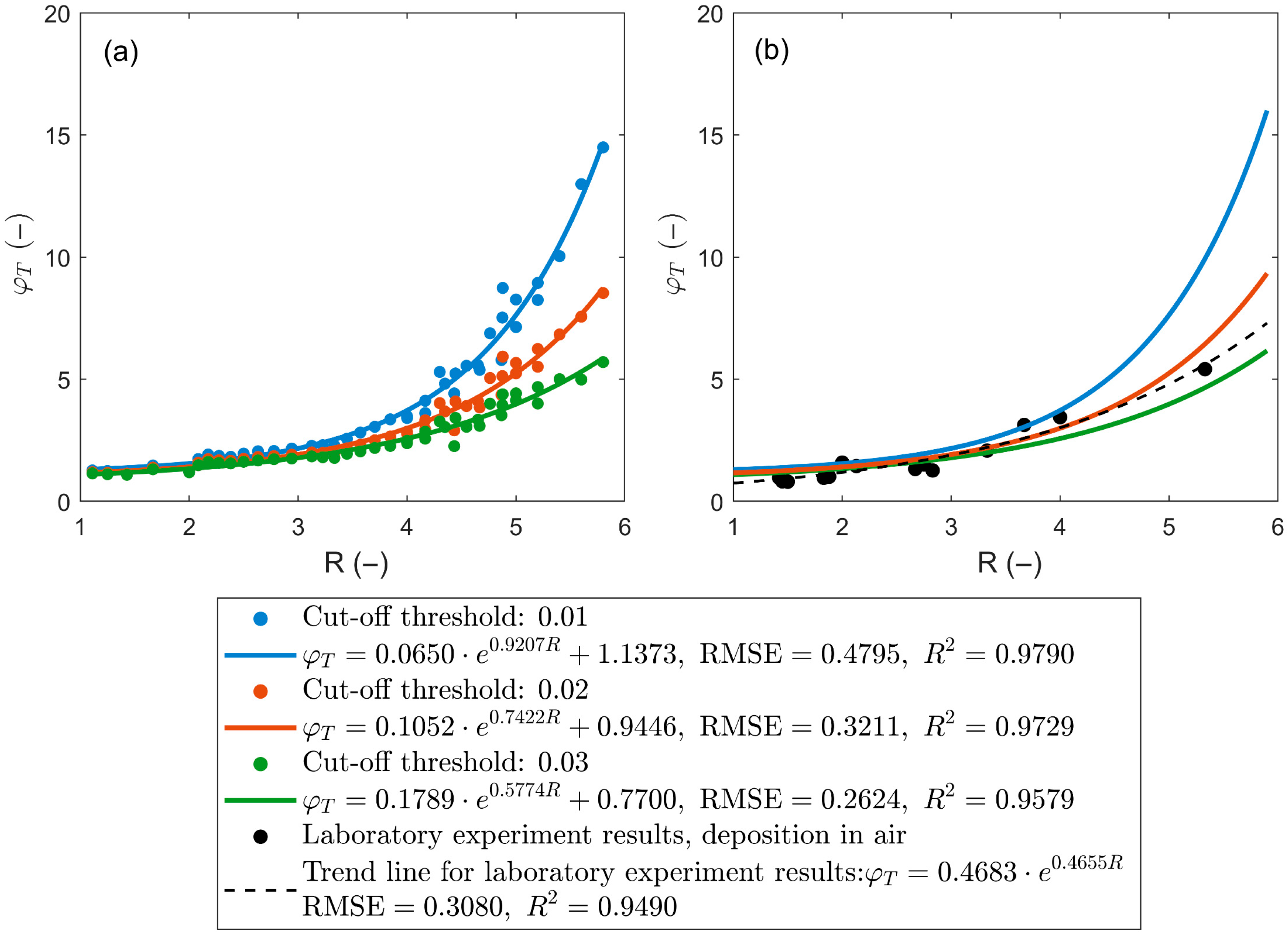
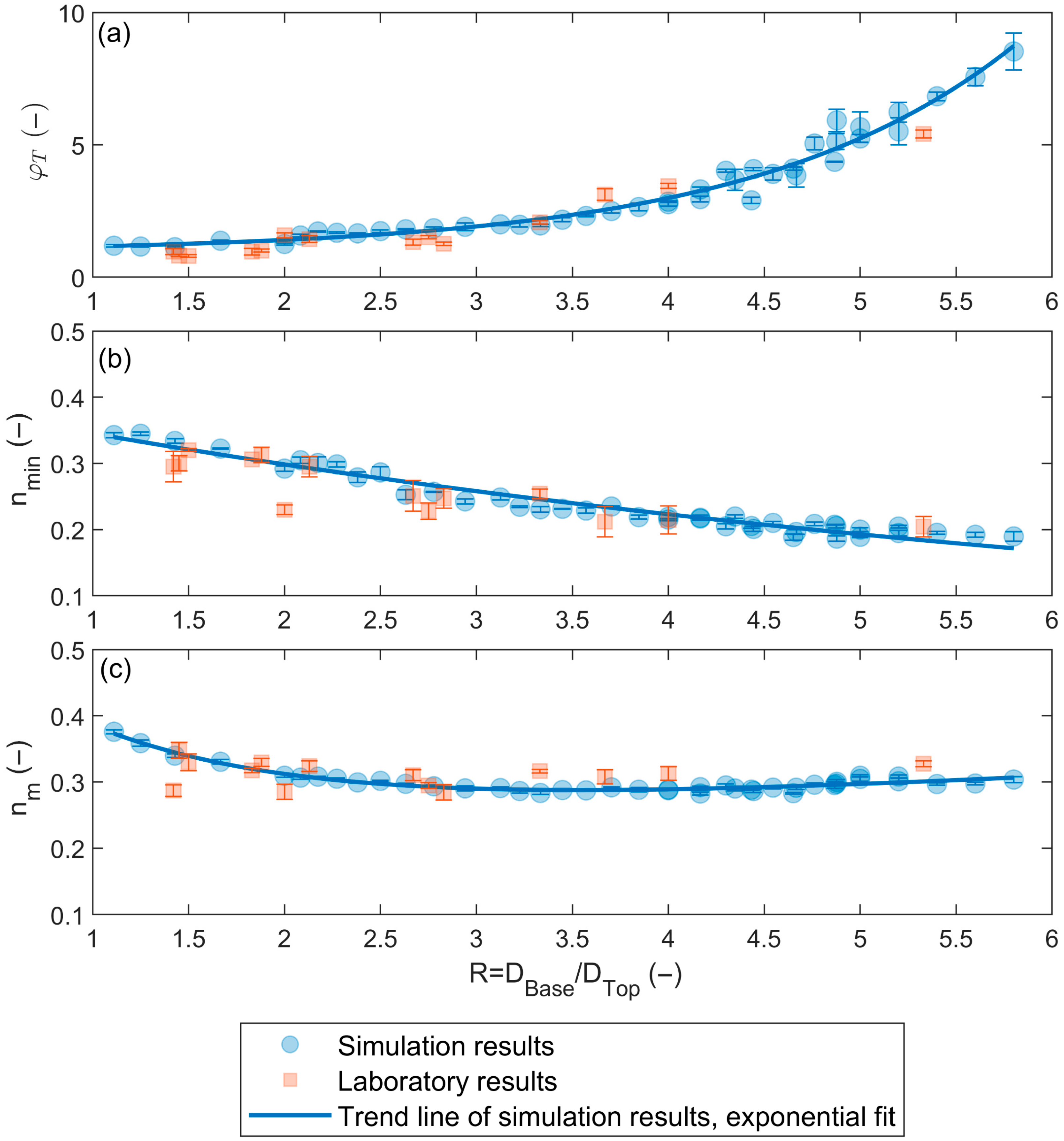
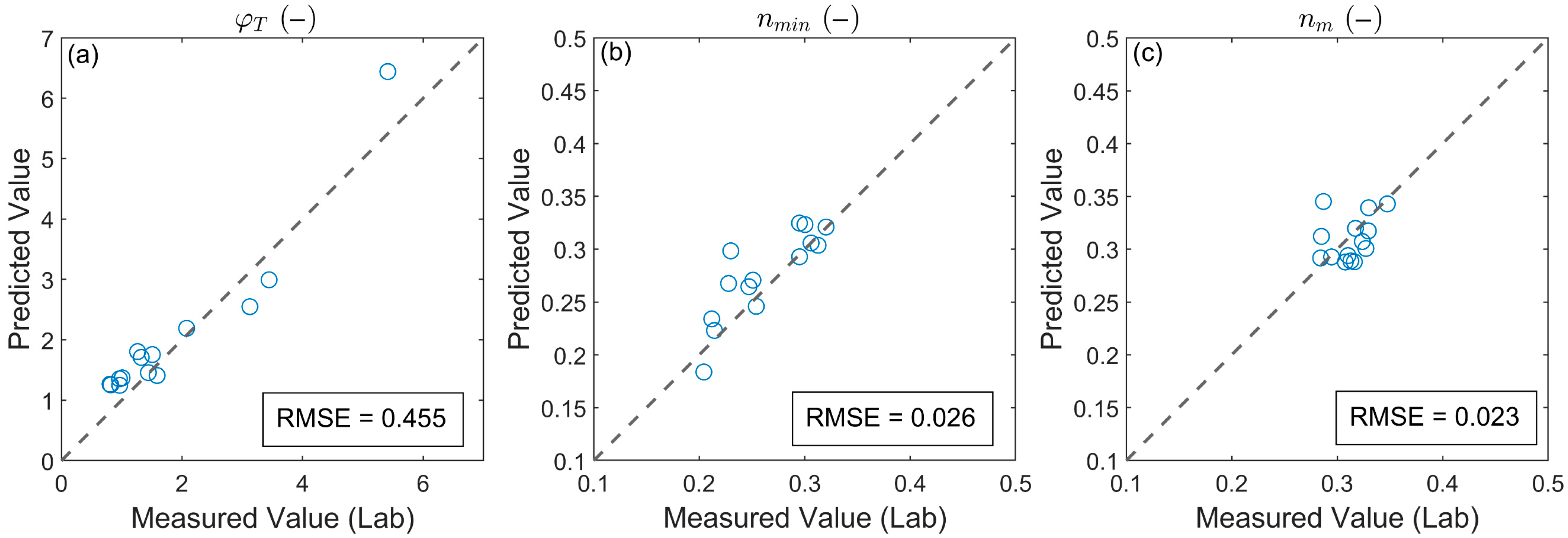

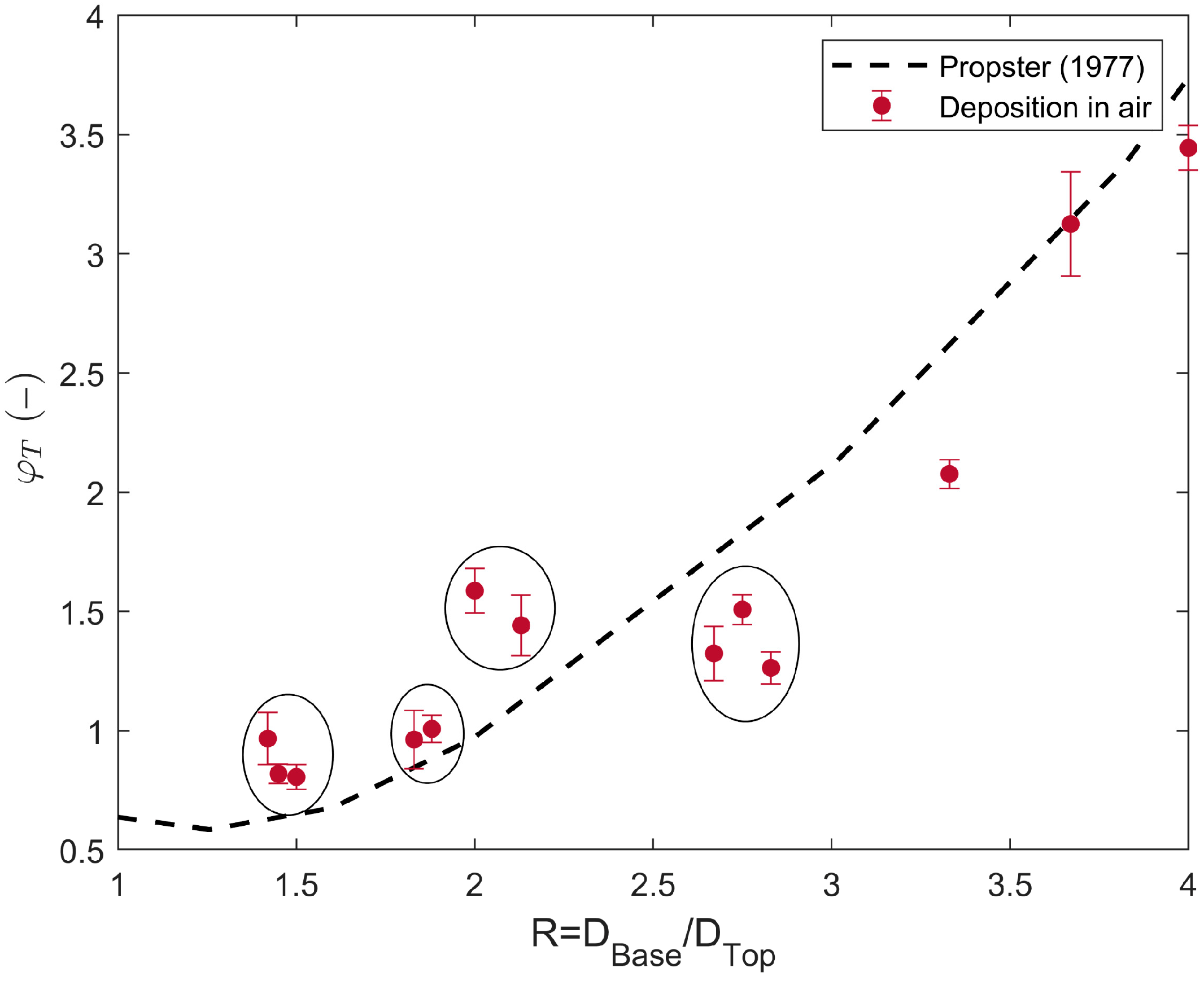
| Deposition in Air | Deposition in Water | ||||
|---|---|---|---|---|---|
| DBase (mm) | DTop (mm) | R = DBase/DTop | DBase (mm) | DTop (mm) | R = DBase/DTop |
| 20 | 6 | 3.33 | 20 | 6 | 3.33 |
| 16 | 11/8.5/6/4/3 | 1.45/1.88/2.67/4.00/5.33 | 16 | 4/3 | 4.00/5.33 |
| 11 | 6/4/3 | 1.83/2.75/3.67 | 11 | 6/3 | 1.83/3.67 |
| 8.5 | 6/4/3 | 1.42/2.13/2.83 | 8.5 | 3 | 2.83 |
| 6 | 4/3 | 1.50/2.00 | 6 | 3 | 2.00 |
| 8.5 | 20 | 0.43 | 8.5 | 20 | 0.43 |
| 4 | 16 | 0.25 | 6 | 20 | 0.25 |
| 3 | 16 | 0.19 | |||
| Simulation Parameters | Model Calibration and Validation | Data Extension |
|---|---|---|
| Buffer length fraction (−) | 0 | 0.1 |
| Fixed Delta Time (s) | 0.005 | |
| Solver Iteration Count (−) | 60 | |
| Sleep Threshold (−) | 0.0005 | |
| Shaking Fraction (−) | 0.001 | |
| Bounciness (−) | 0.926 [67] | |
| Friction coefficient (−) | 0.16 [67] | |
| Drop rate (m3/(m2·s)) | 1.8·10−4 | |
| Density (kg/m3) | 2500 | |
| Materials | Glass beads | |
Disclaimer/Publisher’s Note: The statements, opinions and data contained in all publications are solely those of the individual author(s) and contributor(s) and not of MDPI and/or the editor(s). MDPI and/or the editor(s) disclaim responsibility for any injury to people or property resulting from any ideas, methods, instructions or products referred to in the content. |
© 2025 by the authors. Licensee MDPI, Basel, Switzerland. This article is an open access article distributed under the terms and conditions of the Creative Commons Attribution (CC BY) license (https://creativecommons.org/licenses/by/4.0/).
Share and Cite
Xu, W.; Brüll, C. Stratification-Induced Porosity Variations in Granular Packings–Part I: From Laboratory Measurement to Numerical Modelling. Geotechnics 2025, 5, 77. https://doi.org/10.3390/geotechnics5040077
Xu W, Brüll C. Stratification-Induced Porosity Variations in Granular Packings–Part I: From Laboratory Measurement to Numerical Modelling. Geotechnics. 2025; 5(4):77. https://doi.org/10.3390/geotechnics5040077
Chicago/Turabian StyleXu, Wenjia, and Catrina Brüll. 2025. "Stratification-Induced Porosity Variations in Granular Packings–Part I: From Laboratory Measurement to Numerical Modelling" Geotechnics 5, no. 4: 77. https://doi.org/10.3390/geotechnics5040077
APA StyleXu, W., & Brüll, C. (2025). Stratification-Induced Porosity Variations in Granular Packings–Part I: From Laboratory Measurement to Numerical Modelling. Geotechnics, 5(4), 77. https://doi.org/10.3390/geotechnics5040077






